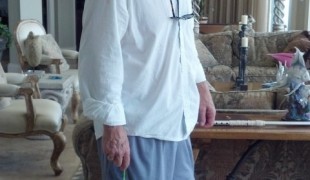- 3601
- 319
- 8
- 11
- 1
- Help Ukraine
About the solution
Sarah realised leaning heavily on her left arm was taking its toll. However, she wasn’t able to couldn’t find a device to help. That’s when she contacted Remap, a charity that helps people with disabilities overcome their problems and to build amazing gadgets, big or small depending on what someone's problem is, helping them to be more independent.
“And they do that by using volunteers like Akshaya all over the UK who give their time freely to build these amazing gadgets, whether it's something really small like mine was, or one of the projects they did last year was enabling a wheelchair user to go up Mount Snowdon”, the patient explained.
So Akshaya came up with a wearable: a light, rechargeable electronic armband with a pressure-sensitive alarm that would make Sarah straighten up, which helps to improve her posture while using a computer.
“Sarah finds that due to lack of core muscle strength she leans too heavily on her left arm when she is working on her computer. This causes her shoulder problems and pain, so she needed something to remind her to correct her posture and sit upright. If she leans too heavily on it for too long, an alarm sounds which reminds her to adjust her posture. The settings can be changed as her core strength improves, so it should bring benefits to her overall health in the longer term”, the inventor described.
This gadget led the engineer to win the Wolff Award at Remap’s National Award.
Adapted from: https://bbc.in/2JcOnn1
https://bbc.in/32xJgp7
https://bit.ly/2Mms8g7
More info: https://www.remap.org.uk/
https://www.youtube.com/watch?v=EcqiCN2JHxQ
This solution shall not include mention to the use of drugs, chemicals or biologicals (including food); invasive devices; offensive, commercial or inherently dangerous content. This solution was not medically validated. Proceed with caution! If you have any doubts, please consult with a health professional.
DISCLAIMER: This story was written by someone who is not the author of the solution, therefore please be advised that, although it was written with the utmost respect for the innovation and the innovator, there can be some incorrect statements. If you find any errors please contact the patient Innovation team via info@patient-innovation.com
-
-
341
-
0
-
4215

Collaborator Pierluigi Mantovani creates Evolution Devices - solutions that aim to transform Multiple Sclerosis Management
CAREGIVING
BODY BALANCE: Maintaining body balance
STANDING UP: Standing up from a seated position
WALKING: Walking
Multiple Sclerosis
Assistive Daily Life Device (to help ADL)
Walking Aid (wheelchair/walker/crutches)
App (Including when connected with wearable)
AI algorithm
Body-Worn solutions (Clothing, accessories, shoes, sensors...)
Restoring mobility
Regaining sensory function
Managing pain
Promoting self-management
Preserving Organ Function
Managing Neurological Disorders
Maintaining Balance and Mobility
To improve Treatment/Therapy
Preventing (Vaccination, Protection, Falls, Research/Mapping)
Raise awareness
Caregiving Support
General and Family Medicine
Internal Medicine
Medical Genetics
Neurology
Physical Medicine and Rehabilitation
United States
-
-
-
705
-
0
-
10415

Assistive walking device
WALKING: Walking
WALKING WITH A WALKING AID: Walking with a walking aid
BODY BALANCE: Maintaining body balance
Body-Worn solutions (Clothing, accessories, shoes, sensors...)
App (Including when connected with wearable)
Assistive Daily Life Device (to help ADL)
Walking Aid (wheelchair/walker/crutches)
Loss of balance
Frequent falls
Restoring mobility
Regaining sensory function
Managing Neurological Disorders
Recovering from Traumatic Injuries
Maintaining Balance and Mobility
Preventing (Vaccination, Protection, Falls, Research/Mapping)
Neurology
Physical Medicine and Rehabilitation
Mobility issues
Solutions for Disabled people
United States
-
-
-
547
-
0
-
8928

Man creates device to help to put on socks, shoes and even trousers
Grip
(SELF)-CARE: DRESSING: Dressing independently.
BODY BALANCE: Maintaining body balance
STANDING UP: Standing up from a seated position
Knee Deformity
Assistive Daily Life Device (to help ADL)
Strategy/Tip
Muscle weakness
Limited range of motion
Muscle pain or stiffness
Reduced grip force (grip)
Loss of muscle coordination
Muscle cramps or spasms
Joint deformity
Joint redness or warmth
Swelling or inflammation
Difficulty bearing weight
Muscle twitching
Difficulty standing from a seated position
Difficulty getting up from the floor
Numbness or tingling in the extremities
Joint pain or swelling
Restoring mobility
Promoting self-management
Preserving Organ Function
Rehabilitating After Stroke
Managing Neurological Disorders
Recovering from Traumatic Injuries
Maintaining Balance and Mobility
Preventing (Vaccination, Protection, Falls, Research/Mapping)
Caregiving Support
Internal Medicine
Neurology
Orthopedics
Physical Medicine and Rehabilitation
Rheumatology
Sports Medicine
Vascular Surgery
United States
-
 en
en
maryaidan • Sat, 10/19/2019 - 04:46
Great post! I didn’t knowral of these resources and I’m going to go check them out now!